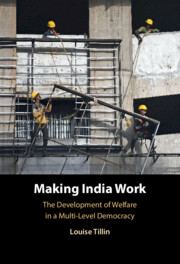Book contents
- Making India Work
- Making India Work
- Copyright page
- Dedication
- Contents
- Illustrations
- Acknowledgments
- Abbreviations
- 1 Introduction
- 2 Origins, Expansion, and Reform
- Part I Building a National Economy: Regulating Internal Competition
- Part II Putting India to Work
- 5 A Girding of Loins
- 6 Electoral Competition and the Expansion of Social Policy to Rural Areas
- Part III Liberalisation and Welfare in a Multi-level Democracy
- Bibliography
- Index
5 - A Girding of Loins
Planning and the Duty to Work in the Postcolonial Welfare State
from Part II - Putting India to Work
Published online by Cambridge University Press: 13 February 2025
- Making India Work
- Making India Work
- Copyright page
- Dedication
- Contents
- Illustrations
- Acknowledgments
- Abbreviations
- 1 Introduction
- 2 Origins, Expansion, and Reform
- Part I Building a National Economy: Regulating Internal Competition
- Part II Putting India to Work
- 5 A Girding of Loins
- 6 Electoral Competition and the Expansion of Social Policy to Rural Areas
- Part III Liberalisation and Welfare in a Multi-level Democracy
- Bibliography
- Index
Summary
State-led planning shaped the path of industrialisation in ways that prevented the expansion of a mass industrial workforce covered by social insurance. This chapter examines how - in conditions of labour abundance but capital scarcity – India’s planners sought to expand the capital-intensive, low-employment capital goods sectors of the economy as the key to unleashing the resources that would in the future be used for investment in the welfare state. In the interim, the majority of Indians would partake in a different form of ‘welfare state’ fulfilling a duty to work via small scale industry and involvement in community works in rural areas. This was a vision of decommodification that privileged the human need for self-creation through work, rather than protection of a minimum level of consumption. The chapter shows that the Nehru-Mahalanobis model overshadowed alternative visions for an Indian welfare state forwarded by sections of Indian business, in which the state would support the growth of mass-employing private consumer goods industries and focus its efforts on investing in human capital and infrastructure.
Keywords
- Type
- Chapter
- Information
- Making India Work , pp. 101 - 122Publisher: Cambridge University PressPrint publication year: 2025

